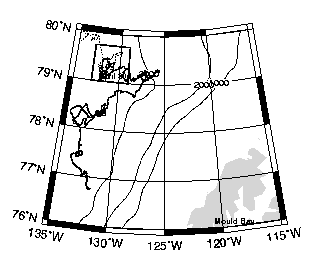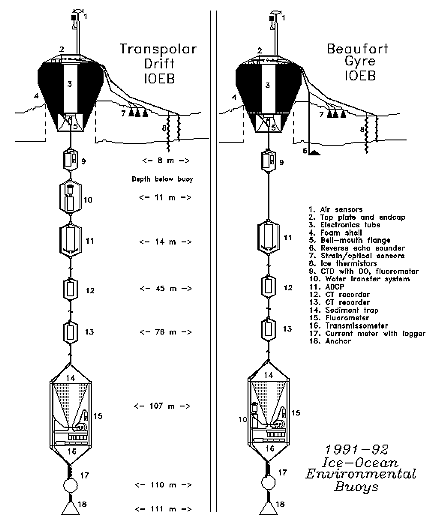1997: Beaufort Gyre IOEB Refurbished
By 00:15 Z, on April 8, 1997, the Ice Ocean Environmental Buoy (IOEB) deployed in the Beaufort Sea was successfully recovered intact at 79.602 N, 130.62 W. Over the next three days, the instruments on the system were dumped of their data and replaced or refurbished for continued performance. By 01:28 Z, on April 11, the system was once again completely deployed and operational in the the icefloe at 79.547 N, 130.96 W. This IOEB system was originally deployed off the coast of Alaska in 1992, drifted in a large clockwise arc for four years before being visited and refurbished for the first time in April 1996. Both refurbishment operations were staged out of the AES Weather Station at Mould Bay, Canada, with logistic support provided by the Space and Naval Warfare Command (SPAWAR), the 109th Air National Guard (ANG), and Polar Associates. In 1997, however, the distance from Mould Bay to the IOEB was reduced considerably, due to the fact that the buoy was located nearly 245 km further southward than in 1996. The primary objectives for revisiting the IOEB again in 1997 were to recover the sediment trap samples acquired over the previous year,
reinstall an Acoustic Doppler Current Profiler (ADCP) onto the mooring system, and to extend the lifetime of the system and all its instrumentation. Each of these objectives was met; in particular, the recovery of the sediment trap samples is particularly noteworthy as it marks the first time that a full year timeseries of valuable particle flux samples acquired under the Arctic pack ice has been obtained from an IOEB.
Remarkably, the entire ice camp operation was performed in only 12 days, including all flights, pioneering and breaking down the ice camp. Due to the professional planning, experience and hardwork of the participants, and good fortune, it is inconceivable that the operation could have been performed more efficiently, or in any less time. The operation could have been extended by poor weather, poor ice conditions for landing (thus requiring the additional time and expense of ferrying by helicopter), or numerous other difficulties associated with the recovery, refit, and redeployment of the IOEB. In fact, between the time of the IOEB recovery and redeployment, the ice camp was separated from the Twin Otter by a wide lead. However, the lead closed when it was time for our return flights, thus alleviating the need to construct an emergency landing strip.
Since redeployment, all instruments (except the S4 module) have been functioning properly and broadcasting reliably. While the transmitters are provided with 3+ year battery packs, most instruments have only 2 year battery packs. The ADCP and S4 will fill their memory in only 1 year. Consequently, we can expect the IOEB to continue to transmit data for several years, but would recommend that the system be refurbished on a 1 to 2 year basis.
Recovery of Beaufort Gyre IOEB in 1997
Scientists from the Japan Marine Science and Technology Center (JAMSTEC) and Woods Hole Oceanographic Institution (WHOI) participated in the operation. From JAMSTEC were Kiyoshi Hatakeyama and Toru Nakamura; from WHOI were John Kemp, Lawrence Costello and Richard Krishfield. Polar Associates provided one field person on the ice (Jeff Lord), and one based in Mould Bay (Ted Gooch). Transportation to and from the ice was by Twin Otter from Kenn Borek Air, piloted by Monty Stevenson and engineered by Dave Bosma.
The science equipment, camp gear, and fuel required for the operation was transported to Mould Bay in March on several C-130 flights by the 109th ANG from Thule AFB in Greenland. On March 30 and 31, all the field personnel travelled together on commercial airlines from Boston, Massachusetts via Ottawa, Ontario to Resolute, Northwest Territories, to meet the Borek Twin Otter. On April 1, the Twin Otter and all personnel arrived in Mould Bay, and an immediate reconaissance was performed over the IOEB site, approximately 350 km west of Mould Bay. The weather was clear and the buoy apex was easily spotted within a few minutes, approximately 25 m from a large ridge which apparently was formed from the refrozen lead which we used as our runway last year. The IOEB was upright, had a light covering of snow, but the meteorological mast and ice strings were intact and without damage. Although a landing did not take place, the pilot was confident that he could land on same floe with the buoy. Consequently, a helicopter was not required, and a corresponding amount of time and work was saved.
On April 2, the first landing on the icefloe occurred, and a load of camp gear deposited. During the next three days, all the remaining gear and all the personnel were installed at the buoy site, employing a total of 8 Twin Otter flights. The camp consisted of three tents, each providing workspace and housing two individuals. The recovery site and apparatus were prepared on April 5 and 6, and an ice core was taken in the icefloe near the IOEB. On the morning of April 7, the retrieval began.
The weather on this day was excellent for the recovery. The skies were clear, there was little wind, and the temperature hovered around -25 øC. The hot water ice drill was started and began cutting a 50 inch hole around the apex at 9:30 AM local (15:30 Z). In less than two hours, the drill penetrated the 14 10” of ice. The ice around the apex and cable was removed by pickaxe and chainsaw. This required the most time and labor of the recovery operation, and the hole was not completely clear of ice until 21:45 Z. Over the next 2.5 hours, each instrument on the mooring system was removed (while being kept warm by a hot air blower), and placed into the science tent. Although it was impossible to keep the sample cups on the sediment trap from freezing during the recovery, fortunately none cracked and no samples were lost. Later, after allowing the system to warm and dry somewhat, the bottles were removed, sealed and stored in a cool environment. All other instruments were allowed to warm and dry overnight in the science tent, and their data dumped the following day.
Full datasets were obtained from each of the three SeaCats on the mooring system, the upper S4 current meter, the transmissometer/fluorometer module, and the sediment trap. Only the deep S4 current meter failed to respond, even when a substitute battery packed was used. Preliminary analysis of the data indicates that the transmitted data compares precisely to the recovered data for each of these instruments, although the recovered data includes points not transmitted, as expected.
Over the next two days, a redeployment site was prepared, the apex refurbished and all instruments initialized for the reinstallation. Meanwhile, a CTD cast was taken down to 500 m through the hole abandoned by the IOEB. The redeployment site was removed about 50 m away from the recovery site, to provide more space away from the icefloe edge. The icefloe thickness was 13 7" here, and another ice core was taken at this site. On April 9, a new 39" deployment hole was cut through the icefloe, and another CTD cast was performed. During this second cast, bottle water for the sediment trap was taken at 100 m.
Redeployment of Beaufort Gyre IOEB in 1997
Redeployment of the IOEB began at 3:20 PM local time (21:20 Z). Although the skies were clear, there was a howling wind adding to the cold. The deployment started by lowering the anchor first through the hole in the icefloe, followed immediately by the S4 current meter, and the sediment trap package. Network communications were checked by manually sending the MUSSIC addresses from a laptop. All instruments responded when interogated. A 30 m shot was deployed next, followed by a SeaCat, and communications verified again. After the second 30 m shot and SeaCat, however, communication with the S4 module failed. Repeated attempts were made, but to no avail. After discussing our options, it was agreed that the best course was to proceed with the deployment despite the lack of S4 module transmissions. The reasons for this decision were: 1) the severe cold wind could disable the other instruments already deployed and functioning, upon being brought up (e.g. possible cracking of the SeaCat conductivity cells and sediment trap bottles), 2) the S4 current meter could still be functioning, eventhough the S4 module would not communciate, so there exists a possibility that upon later retrieval this data may be recovered, and 3) the time schedule of the ice camp operation prohibited extending the redeployment. The remaining 30 m shot, ADCP, 5 m shot, and SeaCat were subsequently deployed and communications verified. Finally, the apex was attached and lowered, the ice thermistors and meteorological mast were installed, and the redeployed system was complete by 01:30 Z, April 11.

